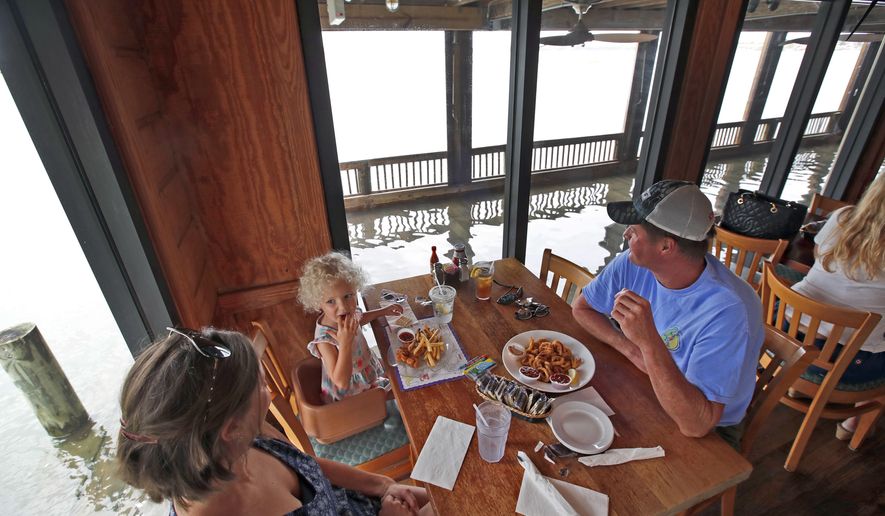OPINION:
Filipino restaurants have been in the Washington area for a long time, usually as informal places. Most of them didn’t last long. In the last few years, however, Washington has discovered Filipino cooking, and there are now a number of Filipino restaurants in the area.
One, Bad Saint (3226 11th St. NW), a tiny restaurant with only 24 seats, was declared the No. 2 best new restaurant 2016 by Bon Appetit magazine. Kuya Ja’s Lechon Belly (5268-H Nicholson Lane, Rockville), a fast casual restaurant, is the most recent, opened in May. It looks like Filipino cuisine is here to stay, a happy note for Washington diners, including the area’s more than 75,000 Filipino residents.
Filipino cuisine is a mix of Chinese, Malaysian, Indonesian, Indian, Arabian, Spanish and American influences, among others. The more than 7,000 islands of the Philippine archipelago have been the center of trade routes in the China and Philippine Seas for centuries. There are more than 100 ethnic groups in the islands and numerous regional styles of cooking.
The original population of Malayo-Polynesians from the central and southern Pacific islands settled the islands around 3200 B.C., bringing rice. Methods of preparing food were boiling, steaming and roasting.
The Chinese traded and settled in the Philippines between 960 and 1279 A.D., introducing noodles (pancit), spring rolls (lumpia) and fried rice (sinangag), as well as soy and fish sauces.
The Spaniards arrived in the 16th century. With them came the taste for richer foods, elaborate desserts, stews, potatoes, tomatoes, corn and chili peppers from the Americas. They introduced sauteing with garlic and onions. Then came hamburgers, French fries and pies after the United States annexed the Philippines after the Spanish-American war of 1898.
Although many spices are used in Filipino cooking, dishes generally are not very hot. No two versions of a traditional dish are alike. The national dish is lechon, or roast pig. (Lechon kawali is seasoned crispy deep-fried pork belly served chopped into pieces.)
Cathal Armstrong, left-handed chef/owner of the recently closed Restaurant Eve in Alexandria, opened his new restaurant, Kaliwa (751 Wharf St. SW), at the Washington Wharf development in March of this year. The name means “left” in Tagalog. The restaurant is a two-tier cavernous space with seating for 185, decorated with Filipino motifs, textiles and furnishings. Seating arrangements are comfortable. Everything is big, except for the portions.
The menu is divided into three cuisines — Filipino, Thai and Korean, but it is not Asian fusion; they are discrete, and reflect the favorite dishes of Chef Armstrong and his wife, Meshelle, who has Filipino roots. The Filipino menu offers three appetizers and half a dozen main courses. The crispy pork and shrimp deep-fried rolls (lumpiang shanghai) are long and as thin as a cigarillo. Although they arrived at the table sizzling hot, they were oddly flavorless. Street barbecue skewers are large rectangles of crisp, tender chunks of pork belly (lechon). Both are served with appropriate dipping sauces.
Wood-grilled half chicken is delicious, with crispy skin and tender, flavorful flesh. The chicken is brined before grilling and thus retains it’s moist quality. Other main courses include pork ribs prepared with garlic, pepper and vinegar; sizzling pork “hash” (made with pig’s head) with a fried egg (sisig); and glass noodles with pork crackling (pancit). Tribute is paid to Spanish and American influences with a lamb stew and grilled rib-eye with onion. Small metal bowls of rice accompany main courses.
Purple Patch (3155 Mt. Pleasant St. NW) is a delightful Filipino restaurant in a row house on the edge of Adams Morgan. Patrons who have reserved are greeted by name with a welcoming note on their table. The decor is on the funky side; it’s noisy with a predominantly young crowd; and the food is great.
Lumpia here are shorter and come in five to a portion with two dipping sauces. They are crisp and delicate with subtle flavors. Lechon kawali are crisp, fried, braised chunks of pork belly, which could serve as an appetizer or small main course.
Classic chicken adobo is a half chicken braised in a mixture of soy sauce, vinegar, garlic and bay leaves. Our serving lacked the potatoes that should come in the broth, and there was only one small piece of bok choy, but the flavor was rich and complex, thanks to the melding of soy sauce and vinegar.
Along with a full menu of Filipino dishes, including a whole fried red snapper, several noodle and fried rice dishes, shrimp dishes and vegetable preparations, the restaurant serves a number of American beef dishes: beef (or mushroom) sliders with kimchi and banana ketchup, steak frites, a ribeye steak, a grilled hamburger and a sirloin (Filipino bistek).
Desserts include the Filipino favorite halo halo (a combination of shaved ice, jackfruit, red mung beans, condensed milk, ice cream and toasted coconut) and a delicious purple yam bread pudding with purple yam ice cream.
Philippine Oriental Market (3610 Lee Highway, Arlington) provides the necessary ingredients for preparing dishes at home. Chef/owner Evelyn Bunoan bought the market in 1978. She studied cooking in France and England and has a degree as a master French chef, but she prepares only her favorite Filipino dishes at the Market on Wednesdays to Sundays from noon to 2 p.m. Try some; you won’t be sorry.
• Corinna Lothar is a Washington writer, critic and frequent contributor to The Times.




Please read our comment policy before commenting.